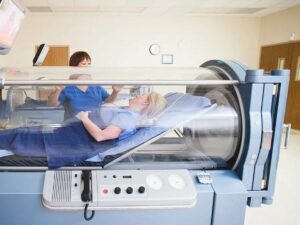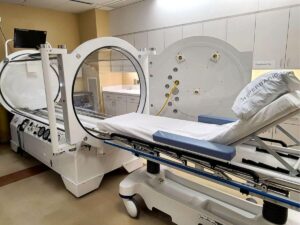Ever wondered how an unassuming chamber could significantly bolster human health and recovery? Mild Hyperbaric Oxygen Therapy (mHBOT) has emerged as a transformative solution in the healthcare sector, yet many business owners are still in the dark about the extent of its therapeutic potential and profitable prospects.
MHBOT is not just a health trend—it’s an innovative therapy with diverse applications across various health-related industries. In this comprehensive guide, we will dive deep into its operational principles, uses, benefits, and investment opportunities. Having experienced firsthand the fascinating world of mHBOT, I’m thrilled to help in navigating this exciting opportunity.
So, tighten up and let’s dive in!
1. Understanding Hyperbaric Oxygen Therapy
Hyperbaric Oxygen Therapy (HBOT) utilizes concentrated oxygen to speed up the healing process and improve overall health. It operates on the principle of delivering high levels of oxygen under increased atmospheric pressure in a controlled environment. Let’s explore its key areas to delve deeper into:
Historical Origins of HBOT
During 17th century, the concept of using pressurized environments for health benefits was first experimented with by a British physician named Henshaw. In the mid-20th century, involving the use of oxygen, and has since been developed into an integral part of various treatment protocols. The transformative journey of HBOT from its humble beginnings to a globally recognized therapy has been truly inspiring.
Technology Involved in HBOT
According to Medscape, HBOT is facilitated through hyperbaric chambers the therapy is breathing 100% oxygen while under increased atmospheric pressure. Ranges from monoplace chambers designed to treat one patient at a time, to multiplace chambers that can accommodate multiple patients. Its environment is enriched with oxygen, which the patient breathes in, elevating the oxygen level in their blood plasma.
Science Behind HBOT
HBOT enhances the body’s natural healing process by exposing the body to pure oxygen under high pressure. This exposure boosts the oxygen concentration in the blood, leading to an increased supply to cells and tissues. The enhanced oxygen supply encourages cell growth and regeneration, reduces swelling, and fosters wound healing. It’s magical how the body can improve its ability to fight infections and eliminate toxins.
2. How Mild Hyperbaric Oxygen Therapy Works
Mild hyperbaric oxygen therapy (mHBOT) is a fascinating interplay between pressure, oxygen concentration, and our body’s physiological response to these elements. It works by increasing the atmospheric pressure in a controlled environment and enriching the air breathed by the patient. Let’s delve in to better grasp the workings of mHBOT.
Increased Atmospheric Pressure
At the heart of mHBOT is the increase in atmospheric pressure. As per an article in AOT, the mild HBOT can reach 988mmHg by using 1.3 ATA while breathing 100% oxygen. The increase in pressure is gradual and monitored to ensure patient comfort. As the pressure rises, the body begins to respond by preparing to absorb more oxygen.
Enriched Oxygen Intake
Parallel to the increased pressure, the air within the mHBOT chamber is enriched with oxygen, often up to 93%. The patient breathes in this oxygen-enriched air, which, thanks to the heightened pressure, has an easier time saturating the body’s tissues, organs, and fluids. I liken this process to giving the body a supercharged boost to life’s most vital element – oxygen.
Enhanced Oxygen Absorption
Under these conditions, the body can absorb up to three times more oxygen than under normal atmospheric conditions. This augmented oxygen absorption leads to a host of beneficial effects, from increased tissue healing to improved immune response. Hyperbaric Chambers designed by ‘OxygenArk’, this enhanced oxygen absorption can be effectively achieved, contributing to the multitude of health benefits.
The table below provides a comprehensive overview of the health benefits associated with enhanced oxygen absorption in Hyperbaric Chambers designed by ‘OxygenArk’, offering insights into how the increased oxygen levels contribute to tissue healing, improved immune response, reduced inflammation, neurological benefits, and enhanced oxygenation to vital organs, promoting overall well-being and therapeutic effects.
| Enhanced Oxygen Absorption |
Health Benefits |
| Up to Three Times More Oxygen |
The hyperbaric environment allows the body to absorb up to three times more oxygen than normal atmospheric conditions, providing higher oxygen levels for various physiological processes. |
| Increased Tissue Healing |
The abundance of oxygen in the body promotes improved tissue healing, particularly in wounds, injuries, and post-surgery recovery. Oxygen is essential for cellular repair and regeneration. |
| Improved Immune Response |
The heightened oxygen levels stimulate the immune system, enhancing its ability to fight infections and diseases. A robust immune response aids in faster recovery and improved overall health. |
| Reduction of Inflammation |
Oxygen-rich environments can reduce inflammation, which is often associated with various health conditions. Lowering inflammation levels supports the body’s healing mechanisms and reduces discomfort. |
| Neurological Benefits |
Enhanced oxygen absorption can positively impact brain function, cognition, and neurological conditions. It may aid in addressing issues like stroke recovery, traumatic brain injuries, and neurological disorders. |
| Enhanced Oxygenation to Organs |
Vital organs, such as the heart and lungs, receive increased oxygenation in the hyperbaric environment, improving their efficiency and overall performance. |
Induced Physiological Response
As a result of this enhanced oxygen absorption, the body responds by producing more ATP (adenosine triphosphate), the ‘energy currency’ of our cells. This increased energy production helps to power various healing and regenerative processes throughout the body. The heightened oxygen levels can stimulate the formation of new blood vessels, further enhancing tissue health and repair.
Completion of Therapy Session
Following the completion of an mHBOT session, the pressure in the chamber is gradually decreased back to normal atmospheric levels. The patient emerges from the session with their body supercharged with oxygen, ready to heal and regenerate. Having witnessed the transformation in patients’ health and well-being post-therapy, the effectiveness of this simple yet powerful process continues to astound me.
3. Benefits of Mild Hyperbaric Oxygen Therapy
Mild Hyperbaric Oxygen Therapy (mHBOT) offers a plethora of health benefits, covering a wide array of physiological domains. Each of these benefits stems from the fundamental principle of mHBOT: increasing oxygen saturation in the body to augment cellular function and foster healing. Let’s explore some of its benefits:

Boosting Immune System
Under the increased oxygen conditions of therapy, the body’s white blood cells are better equipped to destroy harmful bacteria, viruses, and other pathogens. For example, the increased oxygenation aids the production of new immune cells, thus bolstering the body’s defense mechanism. mHBOT led to a significant increase in the immune response of patients undergoing treatment for non-healing wounds.
Anti-Aging and Cellular Rejuvenation
High levels of oxygen promote collagen production, which plays a vital role in maintaining skin’s elasticity and youthful appearance. The elevated oxygen conditions during mHBOT stimulate the body’s stem cells, encouraging the growth and repair of aging or damaged tissues. As an expert, observing the regenerative impact of mHBOT on patients’ skin and overall cellular health never ceases to amaze.
Energy Levels and Vitality
Improved energy levels and vitality are also associated with mHBOT. The high levels of oxygen absorbed into the blood plasma during therapy sessions can improve mitochondrial function—the powerhouse of cells—resulting in increased energy production. Better oxygenation of the brain can lead to improved cognitive function, offering a mental energy boost.
Detoxification and Body Metabolism
With more oxygen available to the body’s cells, the process of converting food and toxins into energy becomes more efficient. This not only aids in detoxifying the body but also promotes a healthier metabolism. In addition, higher oxygen levels can also enhance the body’s ability to eliminate harmful substances, further aiding the detoxification process.
4. Applications of Mild Hyperbaric Oxygen Therapy
The diverse benefits of Mild Hyperbaric Oxygen Therapy (mHBOT) translate into a wide array of applications in both clinical and wellness contexts. The multifaceted benefits and adaptability of mHBOT allows its usage in addressing a range of health scenarios. Here are the featured applications of this therapy:

Neurological Conditions
Oxygen therapy can encourage neurogenesis (growth of new nervous tissue) and help restore function in brain areas affected by conditions such as stroke, traumatic brain injury, or neurodegenerative diseases. Numerous clinical studies demonstrated improvements in cognitive function and quality of life for stroke patients following a regimen of mHBOT.
Sports Medicine
It’s known to speed up recovery from sports-related injuries by enhancing oxygen supply to the injured area, reducing swelling, and promoting healing. mHBOT can also improve athletic performance by increasing stamina and reducing fatigue, thus offering a competitive edge. The value mHBOT brings to sports medicine, particularly in terms of accelerated recovery, is truly impressive.
Chronic Conditions
mHBOT can also aid in the management of chronic conditions, like diabetes and fibromyalgia. For example, mHBOT is often used to treat non-healing ulcers in diabetic patients, with significant success rates reported. By increasing oxygenation and improving circulation, mHBOT can help alleviate symptoms and complications associated with these conditions.
Wellness and Anti-Aging
The therapy’s ability to stimulate collagen production, improve skin health, and boost overall vitality contributes to its popularity in the wellness sector. The enhanced oxygenation provided by mHBOT promotes overall well-being, making it a suitable adjunctive treatment in comprehensive wellness programs. In my professional view, this oxygen-rich journey towards wellness is like aging in reverse gear.
5. Mild Hyperbaric Oxygen Therapy vs Traditional Hyperbaric Oxygen Therapy
Though rooted in the same fundamental principle, increasing oxygen saturation to stimulate healing, mild hyperbaric oxygen therapy and traditional hyperbaric oxygen therapy diverge in several ways. Understanding their distinctions is crucial to contextualize mHBOT’s positioning in the broader therapeutic landscape. Let’s explore how these therapies differ:
Pressure Levels
mHBOT typically operates at lower pressures, generally around 1.3 ATA (atmospheres absolute), making it a safer and more accessible option for many patients. Traditional HBOT, on the other hand, often uses pressures exceeding 2.0 ATA. This difference in pressure levels can affect the patient’s comfort and the risk profile of the therapy.
Oxygen Concentration
HBOT often employs 100% oxygen, mHBOT uses either lower concentrations of pure oxygen or oxygen-enriched air, depending on the specific therapy protocol. This lowered concentration in mHBOT contributes to its safer profile, as it reduces the risk of oxygen toxicity, a concern in traditional HBOT. OxygenArk’s mHBOT and HBOT provide a safer environment, ensuring optimal oxygen concentration throughout the therapy.
Treatment Duration and Frequency
Mild hyperbaric oxygen therapy typically involves sessions that last around 60 to 90 minutes, conducted once or twice daily. Traditional hyperbaric oxygen therapy generally necessitates longer sessions, often between 90 minutes to two hours each. These sessions are typically administered once daily, 5 to 7 days a week. It’s amazing how the two therapies differ, but both look like they have a magical power.
6. The Process of Undergoing Mild Hyperbaric Oxygen Therapy
Mild hyperbaric oxygen therapy (mHBOT) is an innovative method that delivers pressurized air to boost oxygen levels in the body, fostering improved health and recovery. The treatment has gained traction for its efficacy in tackling a myriad of health conditions. Let’s delve into the step-by-step process involved in therapy:

Step#1 Preparation for Therapy
A thorough medical consultation is held prior to the therapy to ensure patient safety and to assess suitability for the treatment. During this stage, medical history is reviewed, any present medical conditions are considered, and potential risks or contraindications are discussed. It is during this phase that all pertinent questions related to therapy are answered.
Step#2 Entering the Hyperbaric Chamber
This stage is marked by a brief adjustment period as the body acclimates to the changing pressure environment. It is common to experience popping in the ears, similar to the sensation felt during a plane’s ascent or descent. The experience is often described as comfortable and non-claustrophobic, with many individuals taking the opportunity to relax, listen to music, or even nap.
Step#3 During the Therapy Session
In the chamber, as the pressure is mildly increased, an enriched oxygen environment is created. This allows for an increase in oxygen absorption by the body’s tissues, fostering enhanced cellular function and regeneration. While most people find the session to be relaxing, it’s important to note that the true impact of mHBOT is on a cellular level, contributing to cumulative health benefits over time.
Step#4 Exiting the Hyperbaric Chamber
Exiting the hyperbaric chamber follows a procedure similar to entering, with a minor difference: the pressure is slowly decreased, mirroring a gentle descent in an airplane. It is essential to maintain calm and relax during this period to avoid any discomfort. Like during the entry phase, some individuals might experience changes in ear pressure, which can be alleviated by yawning or swallowing.
Step#5 Post-Session Activities
While mHBOT does not typically result in fatigue, allowing the body time to process the oxygen-rich environment can maximize therapeutic benefits. Staying hydrated helps support the body’s natural detoxification process, which can be stimulated by the therapy. Some individuals might experience enhanced energy, improved sleep, or a general sense of well-being, underscoring the far-reaching benefits of therapy.
7. The Risks and Side Effects
While mild hyperbaric oxygen therapy (mHBOT) has proven beneficial in various health contexts, it’s essential to consider the potential risks and side effects associated with this treatment. The procedure is generally considered safe, but like all therapies, it carries certain risks that should not be overlooked. Below are some key side effects and risks to bear in mind.

Barotrauma
It is a condition that can occur due to the changes in air pressure during an mHBOT session. This can lead to discomfort or injury in spaces within the body where air is trapped, such as the lungs and ears. While the risk is minimal in mild hyperbaric therapy compared to traditional hyperbaric therapy, it still exists. A patient might experience ear pain, sinus discomfort, or even more severe conditions like pneumothorax in rare cases.
Oxygen Toxicity
Oxygen toxicity is another possible risk, albeit rare, linked to mHBOT. When the body is exposed to high oxygen levels for extended periods, it can lead to oxygen toxicity. This can affect the central nervous system and result in symptoms like nausea, disorientation, and even seizures in extreme cases.
Myopia
Myopia or nearsightedness can be a temporary side effect of mHBOT. Some patients may experience changes in their vision following therapy, but this is generally reversible once the treatment is concluded. Having observed this over the years, I’ve come to view it as a transient trade-off for the long-term health gains that mHBOT can provide.
Claustrophobia
Although the chambers used in mHBOT are roomier and less intimidating than traditional models, claustrophobia, or fear of enclosed spaces, can still be a challenge for some individuals. This is more of a psychological side effect but is worth noting as it could affect the overall therapy experience.
Fatigue
Fatigue can be a common, albeit usually mild, side effect after mHBOT. Some patients might feel tired after a session, as the body adjusts to the increased oxygen levels and cellular activity. It’s usually short-lived and resolves with rest. Personally, I interpret this post-session fatigue as the body’s way of signaling it’s hard at work healing and regenerating.
8. How to Access Mild Hyperbaric Oxygen Therapy
Navigating the path to Mild Hyperbaric Oxygen Therapy (mHBOT) necessitates a firm grasp of available providers and an understanding of the associated costs. This section aims to demystify these aspects, offering guidance on identifying suitable therapy providers and shedding light on the financial elements involved. Here’s a detailed presentation to comprehend:
Places To Find
Identifying an mHBOT provider is a crucial step towards benefiting from this innovative therapy. Let’s explore some potential avenues for finding these services.

- Private hyperbaric clinics: These specialized centers provide hyperbaric oxygen therapy as a core service. An online search for local hyperbaric clinics can help identify these providers, and a direct phone inquiry can confirm if they offer mHBOT.
- Physical therapy centers: Some physical therapy centers incorporate mHBOT into their recovery and rehabilitation programs. Reviewing their service listings online or making a direct inquiry can reveal whether they offer this therapy.
- Chiropractic offices: Certain chiropractic practices also offer mHBOT, recognizing its potential benefits for general wellness and recovery. This can be verified by checking the services section of their website or making a phone inquiry. I see this as a testament to the therapy’s versatility and adaptability across healthcare disciplines.
- Hospital outpatient clinics: Some hospital outpatient clinics may provide mHBOT, although this is less common. Local hospitals can be contacted for information on whether they offer this service.
- Specialized sports recovery centers: Athletes often turn to mHBOT for recovery and performance enhancement, making sports recovery centers another potential source of this therapy. In my research, the services these centers offer can usually be found on their website.
Insurance and Cost Considerations
Navigating the financial aspects of mHBOT is just as crucial as finding a provider. The costs associated with this therapy can vary significantly, making it important to understand potential insurance coverage and out-of-pocket expenses.

- Private health insurance: Given the wide variety of private health insurance policies, out-of-pocket costs for mHBOT can significantly vary. Depending on deductibles, copays, coinsurance, and out-of-pocket maximums, costs could potentially range anywhere from $20 to $200 per session. If mHBOT is not covered, the full cost might reach up to $350 per session.
- Medicare: Medicare may cover mHBOT under certain conditions. Policyholders should consult with healthcare providers and Medicare representatives to determine eligibility. Costs can vary but generally fall within the range of $200 to $450 per session.
- Medicaid: The coverage provided by Medicaid can vary significantly from state to state, with some states offering more extensive coverage for mHBOT than others. If covered, out-of-pocket costs can be quite minimal, potentially as low as $3 to $20 per session depending on individual state Medicaid policies.
- Workers’ compensation insurance: If mHBOT is needed due to a work-related injury or condition and it is covered by the worker’s compensation insurance policy, there may be little to no out-of-pocket cost for the patient. The insurance could cover the full cost of the therapy, which typically ranges from $200 to $450 per session.
Conclusion
Mild hyperbaric oxygen therapy, with its versatility and wide-reaching potential, is undeniably a significant innovation in the field of wellness and recovery. From a personal perspective, remember that the power of knowledge can not be underestimated-it is the bridge that turns challenges into opportunities.
Therefore, don’t hesitate to reach out to OxygenArk for additional product details or questions. As experts in mHBOT, the team is equipped to provide comprehensive insights, ensuring businesses make informed decisions regarding their wellness strategies. Feel free to embark on this journey of exploration, and contact us today!






